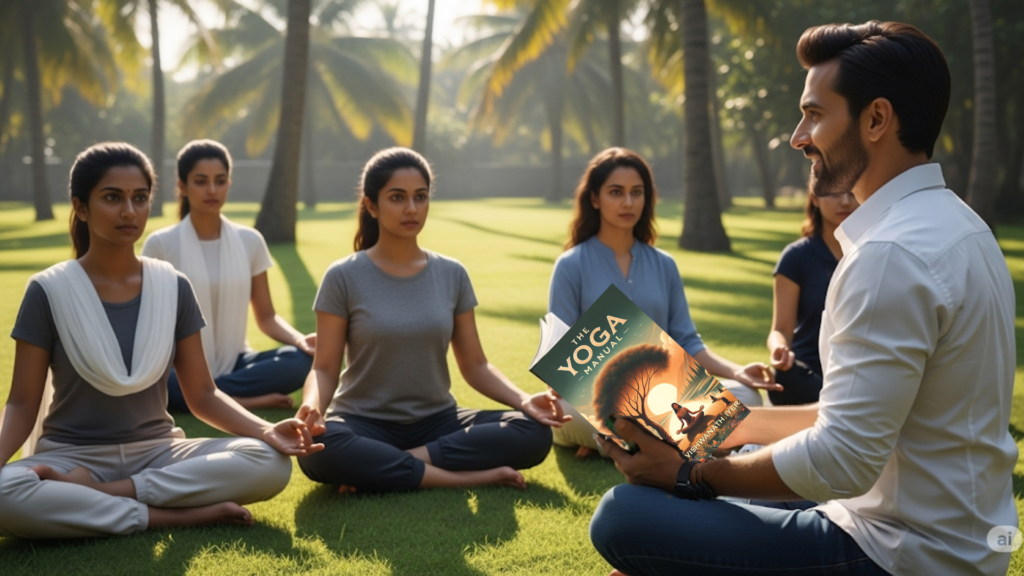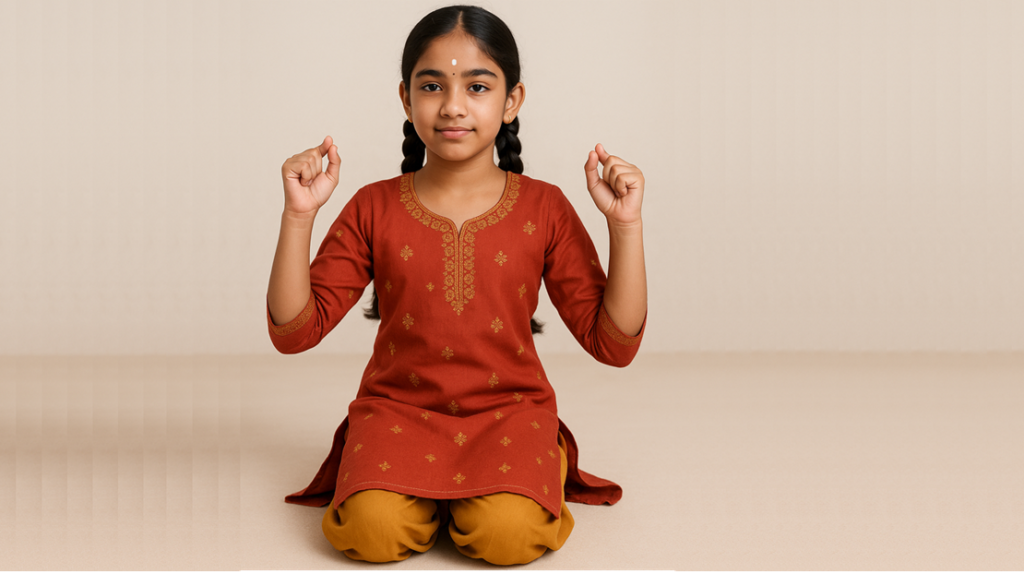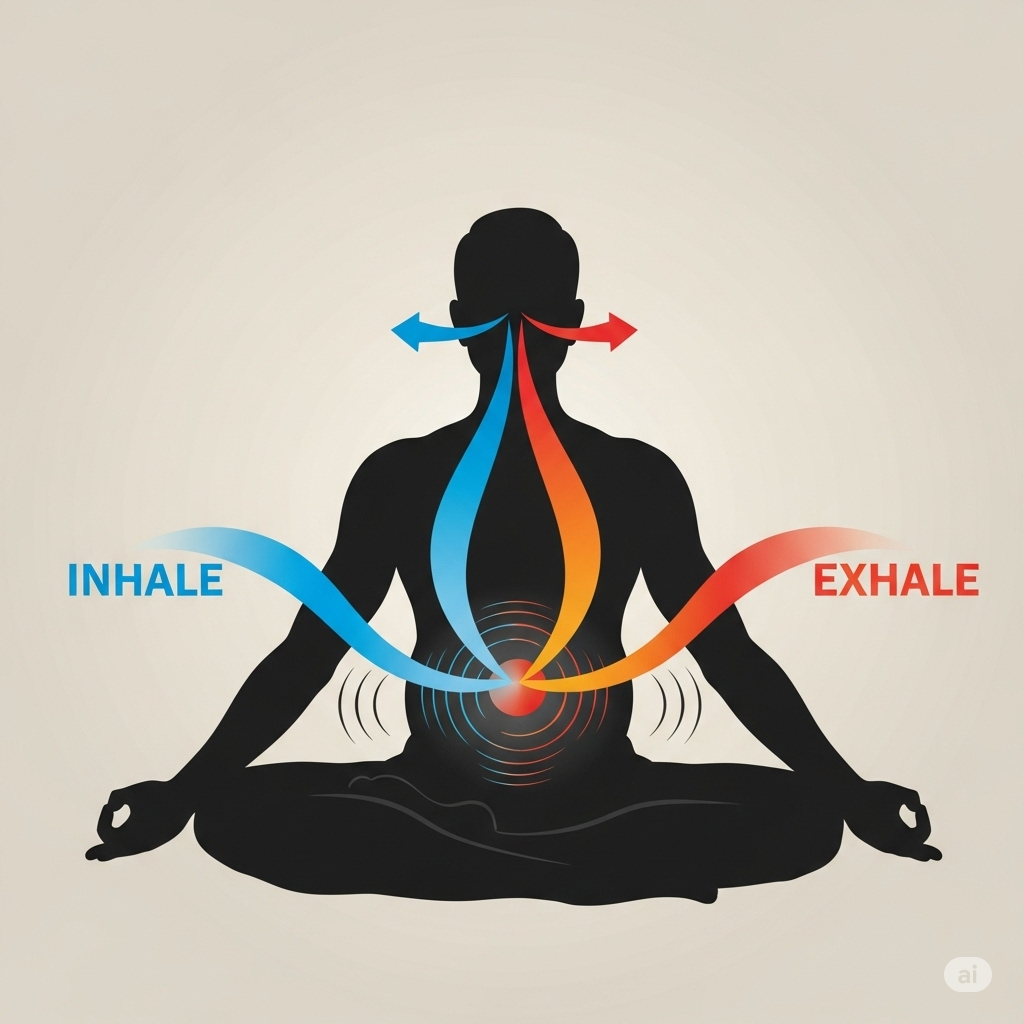Why is prāṇāyāma important?
What are the benefits of prāṇāyāma?
- Stress surely affects our breathing (click for stress and breathing). Therefore, proper breathing can alleviate stress and thus increase situational awareness (prajñā).
- Since oxygen is critical for the conversion of food into energy, proper breathing also impacts all oxidation processes that occur in the body, thereby directly affecting the quality of health.
- Finally, prāṇāyāma is one of the most critical aspects of Hatha-Yoga and Raja-Yoga.
Let us now understand the important terminologies of prāṇāyāma, in separate sections or parts. Each part covers a specific aspect of yogic breathing – such as the energy channels, the prāṇāyāma breathing cycle, etc., and explains the related terminologies of prāṇāyāma.
The terminologies of prāṇāyāma – The energy channels or nāḍī
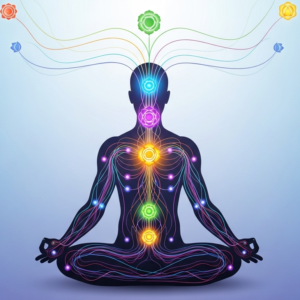
Conscious breathing ensures psychosomatic equilibrium. It channels motility (prāṇa) through channels called nāḍi, ensuring health and wellness. It is important to understand nāḍī when practicing prāṇāyāma. Subtle energy channels (nāḍī) and vortices (cakras) within the body act as conduits of motility (prāṇa) and impact the physical, emotional, and intellectual well-being of the practitioner.
Shiva Samhita designates 14 important nāḍīs, and the most important ones are:
- Idā-nāḍī (comfort in Sanskrit): The idā-nāḍī channel runs to the left of the suṣumṇā-nāḍī and it is pale in colour. Idā-nāḍī is associated with Lunar energy, and thus it is associated with cooler energy. It moves from the left testicle to the left nostril and is associated with the right hemisphere of the brain.
- Piṅgalā-nāḍī (orange-brown in Sanskrit): This channel runs to the right of the suṣumṇā-nāḍī. Piṅgalā-nāḍī is light brown in colour. It is associated with solar energy, and therefore, with hot energy. It moves from the right testicle to the right nostril and is associated with the left hemisphere of the brain.
- Suṣumṇā-nāḍī (which runs in the backbone) – is the central nāḍī, running along the backbone. It comprises 3 subsidiary nāḍīs called vajra, chitriṅi, and brahma which act as the channels through which the kundalini moves upwards from the mūl̄adhāra to the sahasrāra.
The junction of the idā, pingala, and the suṣumṇā-nāḍī at the mūl̄adhāra, is called yuktā-triveni (yuktā = combines + tri = three + veni = streams). When the idā, pingala and the suṣumṇā-nāḍī meet again at the ājñā-cakra, they are called muktā-triveni (muktā = liberated three streams).
The terminologies of prāṇāyāma – The stages in the prāṇāyāma cycle
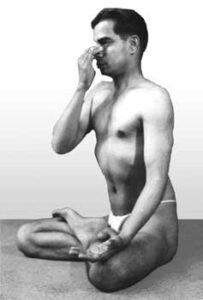
A – Pūraka (inhalation): A single inhalation is termed pūraka. It is a process of drawing in air or inhalation. Also, it should be smooth and continuous. With practice, one can eliminate the breaks in pūraka.
B – Abhyantara-kumbhaka (hold after inhaling): kumbhaka consists of deliberate stoppage of breathing and retention of the air in the lungs after inhalation.
C – Recaka (exhalation): The Recaka is the third stage. It should be smooth and continuous, just like inhalation, though often the speed of exhaling is different from that of inhaling. However, one must always attempt to keep the pace, quality, and flow of exhalation equal to inhalation.
Normally, when inhaling, the abdominal wall descends, drawing down the viscera and stretching it. During kumbhaka, the breath is held, and this exerts a strain on the abdominal wall. The abdominal wall relaxes and collapses inward during recaka. The viscera pushes against the diaphragm, thus emptying the lungs.
D – Bāhyā-kumbhaka (hold after exhaling): The fourth stage is bāhyā-kumbhaka. It is the stage of holding the breath after the exhalation is complete.
The fourth stage thus completes the prāṇāyāma cycle when the retention ends and a new inhalation begins.
The terminologies of prāṇāyāma – Stages of development in prāṇāyāma.
A – Ārambha-avastha (starting state) – In this stage, the prāṇa is stabilized within the body, balancing the various vāyus (airstreams) – such as (prāṇa-vāyu / apāna-vāyu / vyāna-vāyu / udāna-vāyu / samāna-vāyu). When a person practices prāṇāyāma sincerely, the following changes occur;
- He/she begins to perspire profusely. He/she should rub the sweat into the body.
- Also, there is involuntary trembling.
- Sometimes, the body jumps and jerks like a frog.
B – Ghata-avastha (pot state or gathering state)– This is the second stage of prāṇāyāma. This occurs when there is constant suppression of breath. Then, there is a perfect union of prāṇa-vāyu and apāna-vāyu, manas (cognition) and buddhi (logic). Here, the yogi experiences sama-drishti (viewing all creation equally). Also, the yogī experiences clairvoyance, telekinesis, erudition, ability to become invisible and take up any form he desires.
C – Parichaya-avastha (acquaintance state) – Vāyu or breath-flow, pierces the kundalini, which along with agni, enters the suṣumṇā and merges with it. This stage destroys the yogī’s karma. The yogī is thus able to see and manipulate prāṇa.
D – Niṣpatti-avastha (consummation stage) – Here, the yogī’s identity merges with the universal identity and this stage burns away all cycles of birth and death. This is samādhi, mokṣa, the final state.
How should one practice prāṇāyāma daily?
There are several commonly used important terminologies of prāṇāyāma. There are many techniques such as sama-vṛtti (even condition), visama-vṛtti (uneven condition), śītalī (tongue curled between the lips), śītkārin (tongue curled between the teeth), udgīta (prāṇāyāma with chanting). However, the following schedule is adequate to meet daily requirements :
| Prāṇāyāma | Cycles | Benefits |
| Nāḍī-śuddhi with kumbaka | 5-20 | Overall lung functioning, balancing of left/ right brain, balancing of idā and pingala-nāḍī. |
| Bhastrikā | 5-20 | Increases lung capacity, transfer capacity, activates dead alveoli, increases lung elasticity, and also strengthens diaphragm. |
| Kapālabhātī | 25-100 | Increases volumetric efficiency of the lungs, strengthens the trachea and also the pulmonary vessels. Strengthens the abdominal walls as well. |
| Ujjayi | 3-6 | Improves the autonomous nervous system, the heart, and also clears ears and sinuses. |
| Bhramari | 3-6 | Opens the nasal passages, clears all the sinuses, and thus removes mucous. |
| Nāḍī-śuddhi | 5-10 | Close with nāḍī-śuddhi to reset the system. |
Internal Links: Dharma (conditioning), Stress and Situational Awareness, Prana, Asana overview 1, Asana Overview 2, Asana Focus or gazing, Hatha Yoga Pradeepika
External Links: Prana, Chakra, Pancha Tattva, Pancha Prana, Pancha Kosha, Nadi, respiration
- How does prāṇāyāma impact stress situations?
- How can we enhance our prāṇāyāma capability?
- Therapy and prāṇāyāma.
- Patience and prāṇāyāma.
- The right time to do prāṇāyāma.
- Prāṇāyāma and its impact on Situational Awareness
- Diet and prāṇāyāma.
- Can one practice controlled breathing at a bus stop, when waiting at a signal etc. without a conventional setting?
